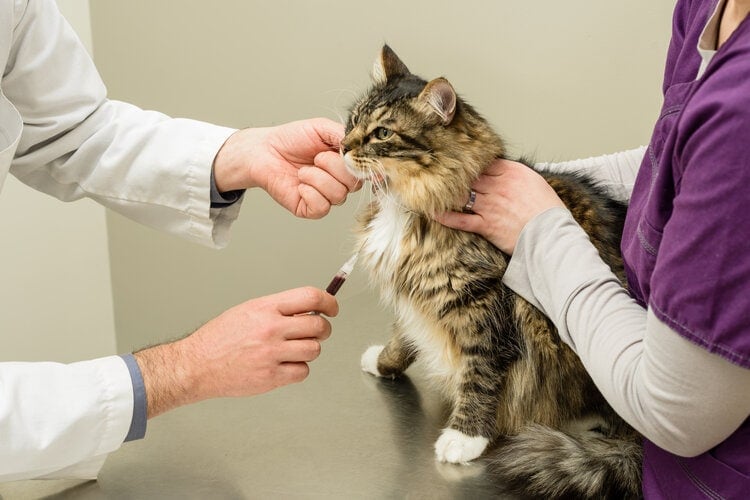How Does Cat Flea Medicine Work? Vet Approved Explanation
By Grant Piper
Updated on
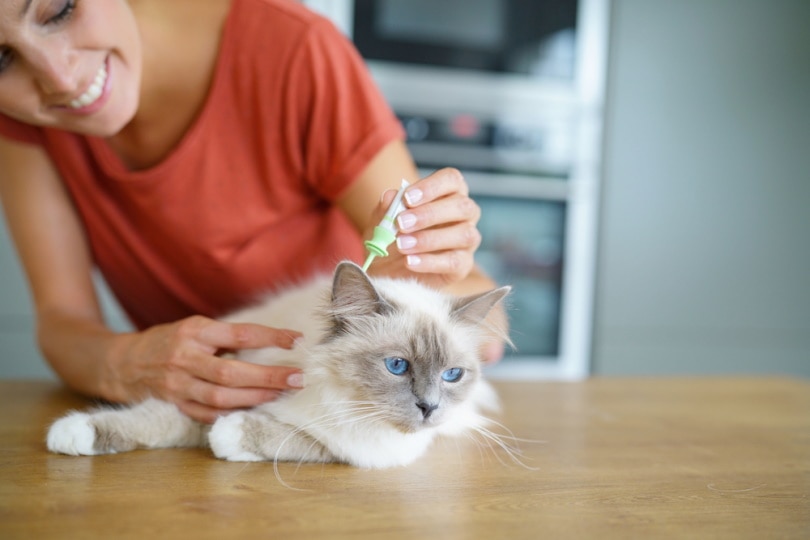
When you go to the vet with your cat, a daunting prospect in many cases, they will often suggest putting your cat on some sort of flea medicine. Flea medicines are designed to prevent and kill fleas so that you do not end up with a frustrating infestation on your hands. But how exactly do they work? It is one thing to say that the medication simply kills fleas, but what is the mechanism? What do you need to be aware of? Are all flea medicines the same? In short, there are more types of flea medicine and it usually attacks the nervous system of fleas, or their eggs.
This overview will cover everything you need to know about how cat flea medicines work, how they are applied, how they kill fleas, and what the most common active ingredients are that do all of the heavy lifting. Flea medications are an integral part of modern pet ownership, so it is good to learn the basics.
The 3 Ways Flea Medicine Kills Fleas
Many flea medicines kill fleas by attacking their nervous system. There are two main ways that they do this:
1. Nervous System Overload
One of the most common ways to kill fleas is to overstimulate their nervous systems. Certain chemicals will cause a flea’s brain to go into overdrive. This causes a variety of side effects, including uncontrollable movement, confusion, and eventually death.
2. Nervous System Disruption
Nervous system disruption is similar to nervous system overload. Instead of causing an increase in chaotic brain signals, disruptors short out the nervous system. This leads to paralysis, lethargy, and eventually death. Most anti-flea medicines work in some way to disrupt the nervous system of fleas, which ultimately leads to death.
There is a secondary goal in that if you scramble a flea’s ability to think and act normally, they are less likely to be able to flee or reproduce effectively. This prevents the fleas from moving on or quickly laying eggs before they die, which helps reduce the overall number of fleas in the long run.
3. Egg and Young Elimination
Another way that flea medications work is by working to eliminate eggs and young fleas. Some chemicals will cause fleas to give birth to babies with no exoskeleton, which is fatal. Others are more concerned with eliminating eggs so that they cannot reproduce, leaving them to die off naturally without spreading.
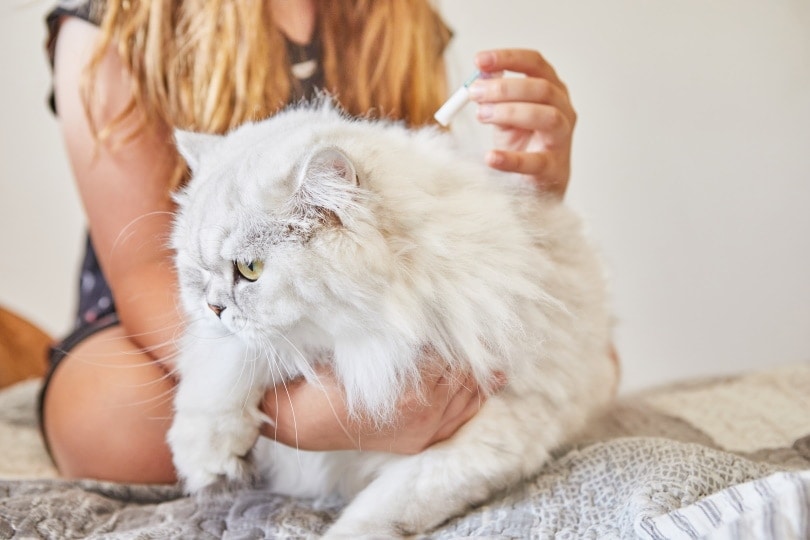
How Different Types of Flea Medications Work
It is very important to note before we start that many dog flea products are highly toxic to cats. You must not use dog flea treatments on cats. Get your flea preparations from your veterinary clinic to ensure effective and appropriate medications.
1. Oral Treatment
Oral treatments are medicines that you give to your cat via the mouth. Oral treatments often introduce a chemical to the cat that will then either circulate through the blood or be excreted through the skin. Oral treatments can come in a solid (chewable or pill) or a liquid. Cats are less likely to receive oral medicines than dogs because cats do not ingest them as readily as their canine counterparts.
2. Flea Shampoo
Flea shampoos are used to rid a cat’s skin of fleas. Flea shampoos are medicated with special chemicals that kill fleas on contact, kill their young and their eggs, and get down to the skin. A flea bath is one of the first things people do if they suspect that their cat has persistent fleas. Flea shampoo can kill fleas on contact, but it is not a preventative. You should pair a flea bath with a new preventative measure to keep fleas at bay for the long term.
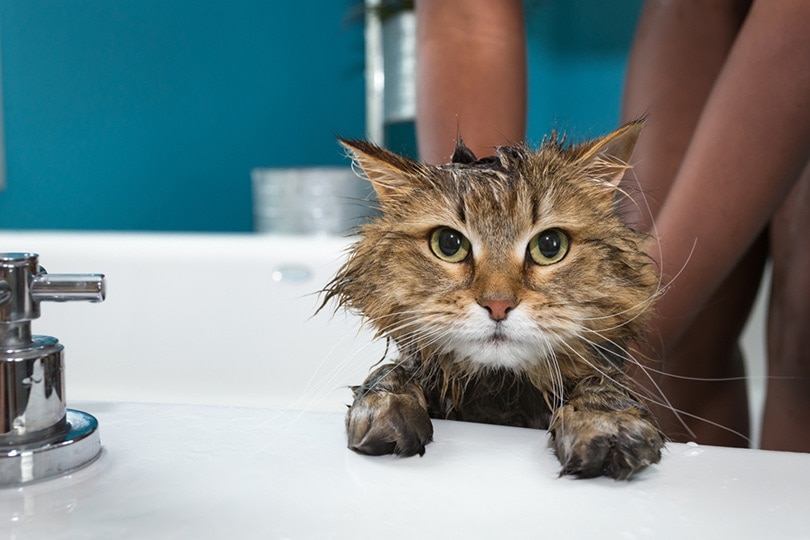
3. Topicals
Topicals, often referred to as ‘spot-on’ treatments, are some of the most common types of flea medicines for cats. Topicals are liquid medications that are applied directly to the cat’s skin. These medicines are placed in a spot where cats cannot lick, usually at the nape of their neck. The spot-on spreads through the lipid/fatty layer of your cat’s skin and is distributed to the hair follicles. If fleas get into your cat’s fur, they will come in contact with the topical medication and die. The medication remains active for a specified period of time- check the manufacturer’s instructions.
4. Flea Collars
Flea collars are similar to topicals, but instead of putting the medicine directly onto your cat’s skin, it gets diffused over time via a special collar. Flea collars are put around a cat’s neck like a regular collar, and they usually last a month or even a few months. Flea collars sometimes have a repellent component or a killing component, depending on what the active ingredient is. Some flea collars are effective but many only protect a small area of your cat, usually around the neck area.
5. Repellent Sprays
There are a variety of sprays available. Some are designed to be sprayed directly onto your cat, while others are only to be used in the environment- on furniture, bedding or carpet. Repellent sprays work in a number of ways. The most basic way is to keep fleas away by just repelling them with natural deterrents. Other sprays work to kill flea larvae or eggs. Sprays can be used to quickly treat your cat if you think they came in contact with fleas, or they can be used to treat an area where your cat spends time.
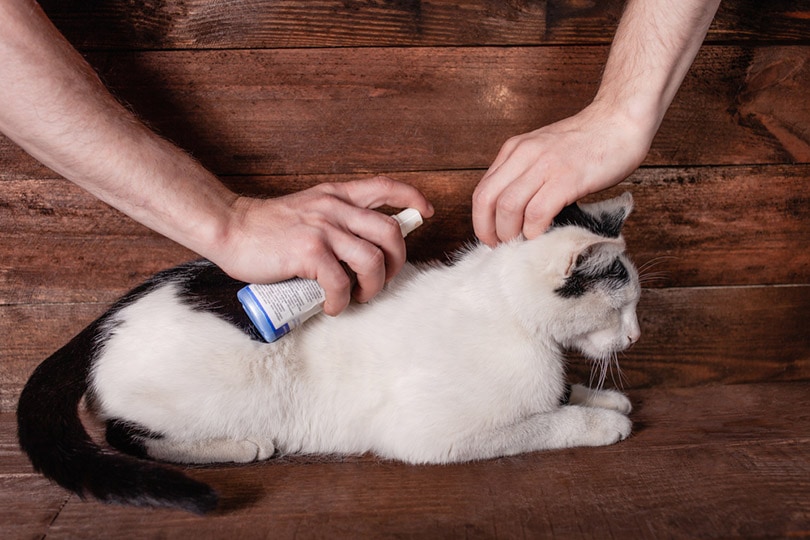
The 6 Primary Active Ingredients in Cat Flea Medicine
Whatever type of flea medicine you choose to use, you will likely encounter one of these key ingredients. These active chemicals are the mechanisms that disrupt and kill fleas. Each one works a little differently and is applied differently. Each active ingredient has a specific function and purpose that will work better for some pets than others.
1. Imidacloprid
Imidacloprid is a topical medication that works to kill fleas. Imidacloprid is one of the most common types of cat flea medicine. Imidacloprid is a nervous system disruptor and tries to work quickly to kill and prevent fleas from laying eggs. This medicine is spread through your cat’s natural oils on the fur and skin.
2. Fipronil
Fipronil is another topical medicine that also disrupts a flea’s nervous system. Fipronil paralyzes fleas and eventually kills them. This is also a common compound found in flea sprays.
3. Selamectin
Selamectin can kill a variety of different parasites that live both inside and outside of your cat. It is applied to the skin, where it is absorbed and gets into the bloodstream. Selamectin is often a part of combination medications that treat things like ticks, fleas, and heartworms all in one. This chemical is another nervous system disruptor.
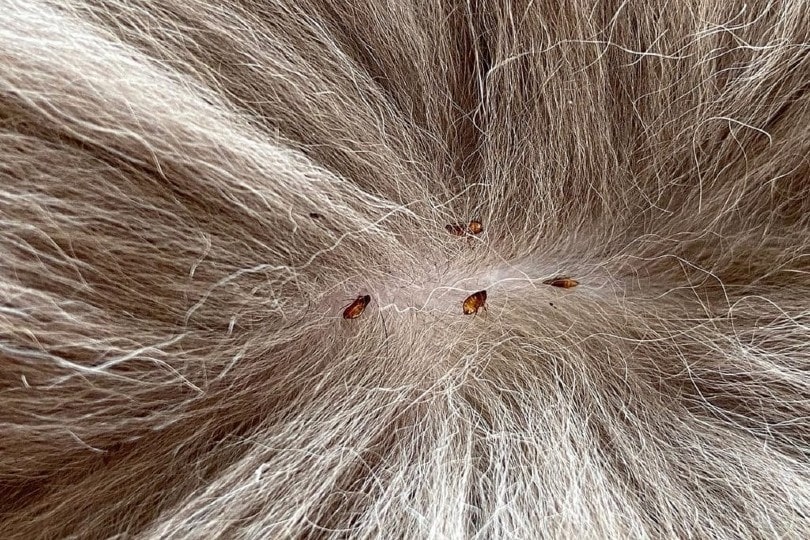
4. Isoxazolines
Isoxazolines are a newer class of parasiticides and include fluralaner,afoxolaner and sarolaner. They kill fleas by causing uncontrolled excitement of the flea’s nervous system and are highly effective.
5. Lufenuron
Lufenuron is usually an oral treatment rather than topical. This chemical is ingested, where it is deposited into the fatty glands of your cat. When a flea bites your cat, it will get a mouthful of lufenuron which will cause its larvae to be born without exoskeletons. This will prevent any fleas from reproducing on your cat, but it will not kill the fleas outright. This is a good medicine to combine with another type that also kills fleas on contact for a good one-two punch.
6. Nitenpyram
Nitenpyram is another oral medication that can be used on both cats and dogs. This medicine kills fleas very quickly, in an hour or less. It is used to eliminate large numbers of fleas on your cat in a short amount of time. However, Nitenpyram is not used for long term flea control and prevention.
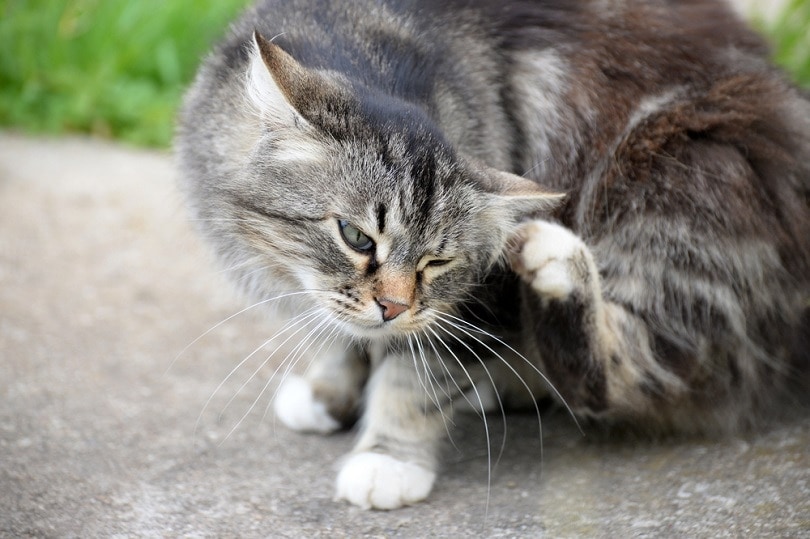
NEVER Use Dog Flea Medicine on Your Cat
You should absolutely never, ever give a cat flea medicine meant for a dog. Dog flea medications often use pyrethrins, a chemical derived from chrysanthemums, to kill and control fleas. Pyrethrins are extremely toxic to cats. If you give a cat flea medication designed for dogs, it could poison and kill them.
Due to the variety of products, active ingredients, and treatment methods, it is advised to go to your vet before buying or applying any flea medication to your cat. All cats are different, and some medications will work better for your cat than others. A vet will also ensure that you give your cat an appropriate product that is both safe and effective.
Conclusion
Flea medicine is more complicated and diverse than many people think. There are multiple different application methods, multiple different active ingredients, and a slew of pros and cons for each. For the best approach for your individual cat, you should consult your veterinarian for professional advice and guidance.
See also:
- Is Acrylic Paint Safe for Dog Paws? Safety Tips & Alternatives
- How Does Cat Flea Medicine Work? Vet Approved Explanation
Featured Image Credit: goodluz, Shutterstock

